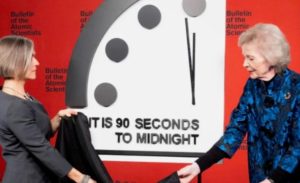I guess it is a sign of when you grew up. Ernest Hemingway’s book, For Whom the Bell Tolls, was a novel written as a mixture of firsthand observation and creative writing in the early 1940s about the war in Spain. Sometimes books get remembered because their title is provocative. Other times, it is because there is a deeper message captured in the title that takes on meaning because you read the book.
Whom the Bell Tolls, was a novel written as a mixture of firsthand observation and creative writing in the early 1940s about the war in Spain. Sometimes books get remembered because their title is provocative. Other times, it is because there is a deeper message captured in the title that takes on meaning because you read the book.
This morning, we read an assessment of the world existential situation each year for the past 75 years, the Bulletin of the Atomic Scientists has published a new Doomsday Clock, suggesting just how close – or far – humanity is from the brink if total destruction. This latest edition was revealed Tuesday at 10 a.m. EST. It showed us at the closest in history … surprise surprise! Read the article here.
Historically, the clock has measured the danger of nuclear disaster, but that’s not the only apocalyptic scenario being considered today. Climate change, bioterrorism, artificial intelligence, and the damage done by mis-and disinformation have now been included in the mix of possible cataclysms. For the past two years, the Doomsday Clock has stood at 100 seconds to midnight, closer to destruction than at any point since it was created in 1947.
What should we be thinking? Here is the conclusion as of Tuesday morning:
Are there any signs of hope?
The scientists and academics behind the Doomsday Clock said there is reason to put faith in humanity’s ability to confront existential threats. The coronavirus pandemic demonstrated that health practitioners and policymakers are “emboldened” to work together in moments of crisis, said Suzet McKinney, principal and director of life sciences for the real estate company Sterling Bay.
Renewable energy technology is also poised to become the world’s largest source of energy within perhaps the next five years, said Sivan Kartha, a senior scientist at the Stockholm Environment Institute and lead author for the Intergovernmental Panel on Climate Change’s Sixth Assessment Report.
Kartha added he is encouraged by the climate activism of the world’s youngest generations, who will face the consequences of failures to constrain fossil fuel use and slow global warming. “That’s something to definitely put some serious hope in,” Kartha said.
Do I really need to dissect how silly this is? Can you see how alarmism has replaced reason? How do you equate climate concerns with global nuclear war? That of course is a doomsday scenario. Our planet has adjusted to much greater swings in climate in its history. We will again.
Plus, renewables have done absolutely nothing to mitigate the increasing carbon dioxide levels, so where is the outrage over that? Renewables (PV and wind) have, in fact, increased the rate of carbon dioxide is being released into the environment. Shouldn’t that be a concern?
It is so clear that climate activism in the world’s youngest generations shows how our education system has brainwashed so many. It has also failed to produce critical thinking individuals. Plus, all too many who know this is all a farce are sitting on the sidelines hoping it will all pass.
I know a lot of very smart people … very very smart people … and not one of them will tell the emperor he is nude besides me.
It is ironic that today’s youth no longer can read the hands on a clock, so maybe it is not surprising they can’t even understand the picture shown in this blog!

AI is a threat we are going to have to deal with. Big tech and others are certain that machines will be smarter than humans within, oh, 10 years. The implications of that are astounding.